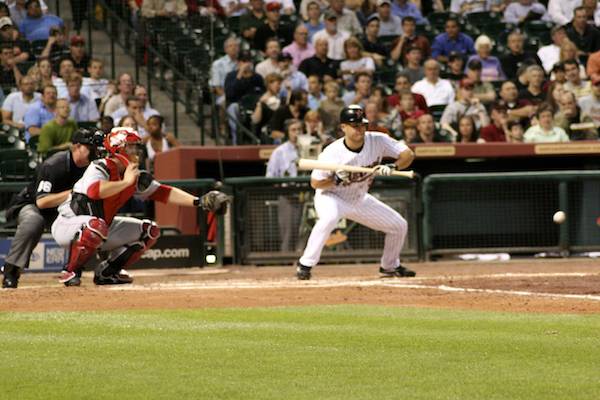Dear Sports Fan,
How does a bunt work in baseball? And why is it so controversial right now?
Thanks,
Otis
— — —
Dear Otis,
A bunt is a baseball tactic where the batter hits the ball softly and directs it onto the ground. This tactic is often used as a form of sacrifice where the batter knows that she is likely to be thrown out at first base but a runner already on first, second, or less normally, third base will be able to easily advance to the next base. It’s a very old tactic and has always been controversial for one reason or another for more than a hundred years. Bunting is in the news a lot right now because the Kansas City Royals have been bunting far more than normal and have won their first two playoff games. Let’s make this a two-part post. We’ll handle how bunts work in the first half and then look into why it’s controversial in a second post.
How does a bunt work?
When a batter decides to bunt or is given instructions to bunt, she waits until the pitcher is starting to pitch and then quickly does two things: she slides her hands up the barrel of the bat and separates them for better control; as she is doing this, she pivots so that her body opens up towards the pitch. Once in bunting position, the batter does her best to make contact with the top half of the ball, so that instead of popping up for an easy out, the ball goes downwards. Advanced bunters are able to also direct the ball towards their base or first, whichever is going to be harder for the defense to field.
Getting into bunting stance does not count as a swing. A strike can only be called if, once the player is in bunting stance, they make a “movement indicating an attempt to contact the ball.” This is a wrinkle in baseball’s rules so obscure that most players and umps don’t even know this, so you will see players draw back from their bunt position if they believe the pitch is out of the strike zone and they want to ensure themselves a ball instead of a strike. A better known bunting rule is that a foul ball on a bunt attempt may count as a player’s third strike. If a batter swings at the ball and fouls it off, that can never count as a third strike, but a bunt attempt can. A foul ball is one that passes outside of first or third base. Since most bunts don’t go that far, wherever the ball stops rolling determines whether it’s fair or foul. Here’s an example of a bunt hit perfectly down the line which flummoxed the defense which was hoping it would roll foul:
If the defensive team notices that a batter is trying to bunt or thinks they might from the context of the game, they may shift where they line up in the infield to position themselves better to respond to a bunt. This usually means closer to home plate. When a bunt is made, the infielders will charge towards the rolling ball and try to get to it in time to pick it up and throw a runner out. Here’s a third baseman fielding a bunt perfectly:
As we mentioned before, a lot of bunters bunt with the intention of sacrificing themselves for the good of a runner on base. This is called a sacrifice bunt and is most often done to move a runner from first to second base. Once on second base, a runner is generally though of as in “scoring position” because they can usually make it home on any ball hit safely into the outfield. This makes it less necessary to sacrifice an out to move them to third base. A special kind of sacrifice bunt is called a squeeze play. This is when a sacrifice bunt is made to get a runner from third to home base. Sounds crazy, right? An even more daring play is the “suicide squeeze” where the runner from third starts running home before the batter even makes contact with the ball. This takes real confidence in the ability of the batter to successfully bunt the ball because if they don’t, you’ve got the catcher standing there waiting to tag the runner out. Some players use the bunt without any sense of sacrifice. They bunt because they are good at bunting and fast enough to make it a reasonable way to get safely to first base. Bunting for a base hit means that you’re basically giving up on the idea of hitting a double, triple, or home run (although doubles do sometimes happen off of bunts!) but it can still be a good strategy, especially if you can surprise the fielders by bunting when they are not in position to field the bunt.
So, that’s how a bunt works. We’ll dig into why bunts are controversial soon.
Ezra Fischer

